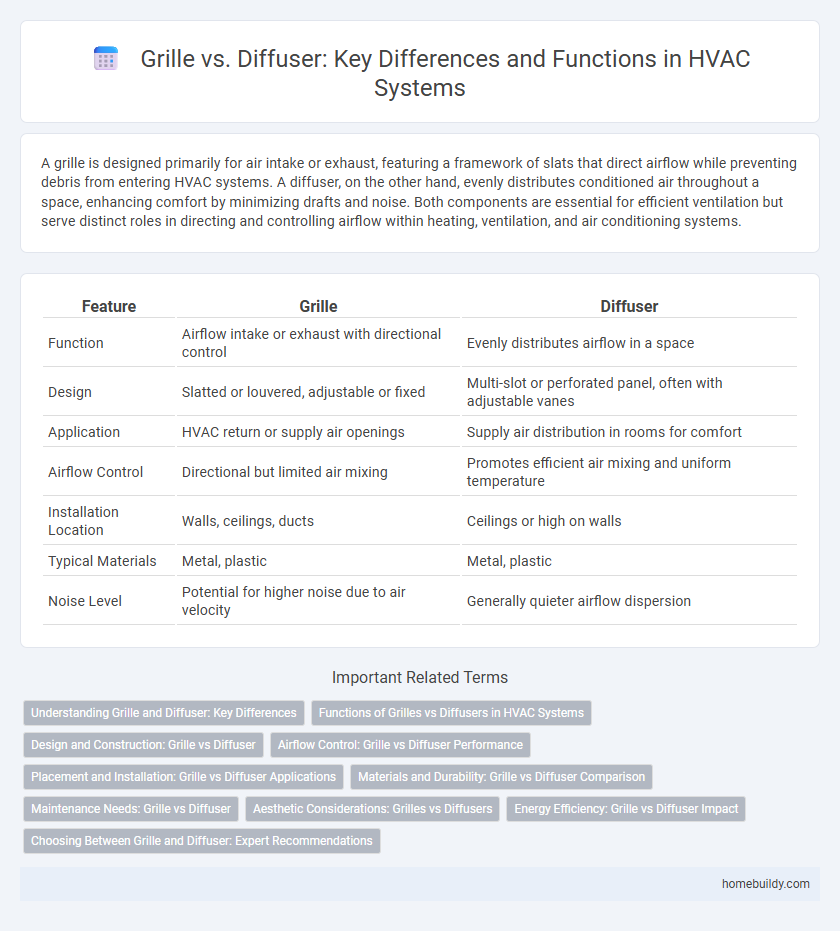A grille is designed primarily for air intake or exhaust, featuring a framework of slats that direct airflow while preventing debris from entering HVAC systems. A diffuser, on the other hand, evenly distributes conditioned air throughout a space, enhancing comfort by minimizing drafts and noise. Both components are essential for efficient ventilation but serve distinct roles in directing and controlling airflow within heating, ventilation, and air conditioning systems.
Table of Comparison
| Feature | Grille | Diffuser |
|---|---|---|
| Function | Airflow intake or exhaust with directional control | Evenly distributes airflow in a space |
| Design | Slatted or louvered, adjustable or fixed | Multi-slot or perforated panel, often with adjustable vanes |
| Application | HVAC return or supply air openings | Supply air distribution in rooms for comfort |
| Airflow Control | Directional but limited air mixing | Promotes efficient air mixing and uniform temperature |
| Installation Location | Walls, ceilings, ducts | Ceilings or high on walls |
| Typical Materials | Metal, plastic | Metal, plastic |
| Noise Level | Potential for higher noise due to air velocity | Generally quieter airflow dispersion |
Understanding Grille and Diffuser: Key Differences
Grilles primarily serve as decorative covers for HVAC systems, designed to protect duct openings while allowing air to pass through efficiently. Diffusers, on the other hand, are engineered to distribute and direct airflow evenly throughout a room, enhancing air circulation and comfort. Key differences lie in their functions: grilles focus on air intake or exhaust protection, whereas diffusers optimize air distribution patterns within indoor spaces.
Functions of Grilles vs Diffusers in HVAC Systems
Grilles primarily serve to cover duct openings while directing airflow and containing return air in HVAC systems, often featuring adjustable louvers for controlling air distribution. Diffusers are designed to evenly distribute conditioned air throughout a space, reducing drafts and enhancing occupant comfort by breaking up air streams into smaller, more diffuse flows. Together, grilles manage air intake and exhaust zones, whereas diffusers optimize air dispersion for balanced temperature control.
Design and Construction: Grille vs Diffuser
Grilles feature a rigid, perforated design constructed from metal or plastic, primarily serving as air intake or exhaust points with adjustable louvers for directional control. Diffusers focus on airflow distribution with a smooth, curved design that promotes even air dispersion across a wider area, often made of lightweight materials like aluminum or plastic composites. The grille's robust structure supports durability and control, while diffusers emphasize aerodynamic efficiency and aesthetic integration in HVAC systems.
Airflow Control: Grille vs Diffuser Performance
Grilles provide precise airflow control by directing air in a fixed pattern, making them ideal for targeted ventilation and better room pressurization. Diffusers, designed for wider air distribution, promote even airflow and reduce drafts by diffusing air more gently throughout the space. Choosing between grilles and diffusers depends on the desired airflow intensity and distribution requirements for optimal HVAC performance.
Placement and Installation: Grille vs Diffuser Applications
Grilles are typically installed over HVAC ducts on walls or ceilings to regulate airflow while maintaining aesthetic appeal, making them ideal for return air or supply air applications where adjustment is needed. Diffusers are strategically placed to evenly distribute conditioned air throughout a room, often mounted on ceilings for optimal air dispersion and comfort. The installation of grilles is generally simpler and suited for areas requiring airflow control, whereas diffusers demand precise positioning to achieve balanced air distribution and minimize drafts.
Materials and Durability: Grille vs Diffuser Comparison
Grilles are typically constructed from durable materials such as steel, aluminum, or high-grade plastics, offering robust resistance to impact and corrosion. Diffusers, often made from lighter materials like plastic or lightweight aluminum, prioritize aerodynamic design over ruggedness, which may result in less durability under harsh conditions. Choosing between grilles and diffusers depends on the environmental demands, where grilles excel in strength and longevity, while diffusers focus on airflow management with moderate durability.
Maintenance Needs: Grille vs Diffuser
Grilles typically require less maintenance than diffusers due to their simpler design and fewer moving parts, reducing the frequency of cleaning and repairs. Diffusers, with adjustable louvers and complex air distribution mechanisms, often accumulate dust and debris that necessitate more regular inspection and cleaning to maintain optimal airflow. Proper maintenance of both components is essential for HVAC efficiency, but grilles generally offer a more straightforward upkeep process.
Aesthetic Considerations: Grilles vs Diffusers
Grilles typically offer a sleek, linear design that integrates seamlessly with modern architecture, enhancing room aesthetics with minimal visual disruption. Diffusers, on the other hand, provide a more varied and sometimes decorative appearance, often complementing traditional or ornate interiors by dispersing airflow through radial or directional patterns. Choosing between grille and diffuser designs depends on the desired visual impact and how well each fits the overall interior style.
Energy Efficiency: Grille vs Diffuser Impact
Grilles and diffusers play distinct roles in HVAC systems, influencing energy efficiency through airflow distribution. Grilles primarily direct air with minimal resistance, potentially causing uneven temperature zones and increased energy consumption as systems compensate. Diffusers optimize air dispersion, promoting uniform temperature distribution that reduces HVAC workload and enhances overall energy savings.
Choosing Between Grille and Diffuser: Expert Recommendations
Selecting between a grille and a diffuser depends on airflow distribution and aesthetic preferences; grilles typically offer higher airflow capacity and easier installation, making them ideal for ventilation systems requiring strong air movement. Diffusers provide more uniform air distribution with adjustable vanes to direct airflow, enhancing comfort in living spaces by minimizing drafts and noise. HVAC professionals recommend grilles for industrial or commercial applications and diffusers for residential or office environments where even air distribution is crucial.
Grille vs Diffuser Infographic

 homebuildy.com
homebuildy.com